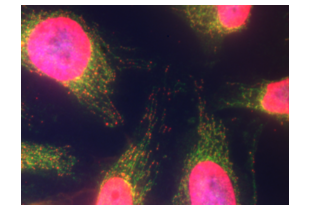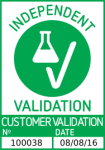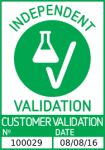C10orf2 Antikörper (Middle Region)
-
- Target Alle C10orf2 (C10ORF2) Antikörper anzeigen
- C10orf2 (C10ORF2) (Chromosome 10 Open Reading Frame 2 (C10ORF2))
-
Bindungsspezifität
- Middle Region
-
Reaktivität
- Human, Maus, Ratte, Rind (Kuh), Meerschweinchen, Pferd, Hund, Kaninchen, Zebrafisch (Danio rerio)
-
Wirt
- Kaninchen
-
Klonalität
- Polyklonal
-
Konjugat
- Dieser C10orf2 Antikörper ist unkonjugiert
-
Applikation
- Western Blotting (WB)
- Sequenz
- GVFRKFATDN NCHVTLVIHP RKEDDDKELQ TASIFGSAKA SQEADNVLIL
- Homologie
- Cow: 100%, Dog: 100%, Guinea Pig: 100%, Horse: 100%, Human: 100%, Mouse: 100%, Rabbit: 100%, Rat: 100%, Zebrafish: 93%
- Produktmerkmale
- This is a rabbit polyclonal antibody against PEO1. It was validated on Western Blot using a cell lysate as a positive control.
- Aufreinigung
- Affinity Purified
- Immunogen
- The immunogen is a synthetic peptide directed towards the middle region of human PEO1
-
-
- Applikationshinweise
- Optimal working dilutions should be determined experimentally by the investigator.
- Kommentare
-
Antigen size: 684 AA
- Beschränkungen
- Nur für Forschungszwecke einsetzbar
-
- by
- Mitochondrial Biology, University of Eastern Finland
- No.
- #100038
- Datum
- 08.08.2016
- Antigen
- PEO1 antibody - middle region
- Chargennummer
- QC6322
- Validierte Anwendung
- Western Blotting
- Positivkontrolle
- HeLa cells, HeLa cells overexpressing PEO1
- Negativkontrolle
- rho0 HeLa cells
- Bewertung
- Passed, regarding sensitivity and specificity. The antibody detects an antigen at the expected apparent molecular weight of its antigen.
- Primärantikörper
- ABIN2775251
- Sekundärantikörper
- Goat-anti rabbit IgG (H+L), HRP-linked (Invitrogen, A-16104)
- Full Protocol
- Cell lysates were propared from HeLa cells, HeLa cells overexpressing PEO1, and rho0 HeLa cells.
- 75µg total protein or each sample were separated on a denaturing 8% SDS-PAGE gel (Laemmli 1970).
- Immunoblot onto supported nitrocellulose membrane (Protran, GE Healthcare No. 1060005, 0.2µm) (Towbin et al., 1979).
- Blocking of the membrane in 3% skim milk in TBST (50mM Tris-HCl, pH 7.4, 150mM NaCl, 0.1% Tween 20) for 1h at room temperature.
- Incubation with primary antibody ABIN2775251 diluted 1:1000 in 3% BSA in TBST at 4°C overnight.
- Washing in TBST for 3x 5min.
- Incubation with goat-anti rabbit IgG (H+L), HRP-linked (Invitrogen, A-16104) diluted 1:15000 in 3% BSA in TBST for 1h at room temperature.
- Washing in TBST for 5x 10min.
- Chemiluminescence detection with luminol solution (250µg/ml Na-Luminol, 0,01% H2O2, 11µg/ml p-hydroxy-coumaric acid in 100mM Tris pH 8.5) and image capture on Kodak ECL film.
- Anmerkungen
- PEO1 runs usually at 95-100 kDa, although the theoretical size is 72 kDa, often it is also visible as dimer.
Validierung #100038 (Western Blotting)![Erfolgreich validiert 'Independent Validation' Siegel]()
![Erfolgreich validiert 'Independent Validation' Siegel]() ValidierungsbilderProtokoll
ValidierungsbilderProtokoll -
- by
- Mitochondrial Biology, University of Eastern Finland
- No.
- #100039
- Datum
- 08.08.2016
- Antigen
- PEO1 antibody - middle region
- Chargennummer
- QC6322
- Validierte Anwendung
- Immunocytochemistry
- Positivkontrolle
- Mouse-anti-ds DNA antibody (clone 35I9)
- Negativkontrolle
- Bewertung
- Passed, regarding sensitivity and specificity. The antibody shows a staining pattern consistent with the expected mitochondrial localization of PEO1.
- Primärantikörper
- ABIN2775251
- Sekundärantikörper
- Goat-anti-Rabbit IgG (H+L) Secondary Antibody, Alexa Fluor 488 conjugate (Invitrogen, A-11034, Lot 702323)
- Full Protocol
- HeLa cells were grown in DMEM high glucose + 10% FBS on acid-cleaned glass coverslips to 50% confluency.
- Cells were fixed in 4% para-formaldehyde in growth medium for 25min at RT, then washed once with growth medium and twice with PBS.
- Permeabilization was achieved by incubation with 0.5% Triton X-100, 10% fetal bovine serum in PBS for 15min.
- Primary antibodies:
- ABIN2775251 diluted 1:200 in PBS with 0.1% Triton X-100 , 10% fetal bovine serum.
- Co-staining of mitochondrial DNA with monoclonal antibody mouse-anti-dsDNA clone 35I9 DNA (Abcam ab27156, Lot GR27035-10) diluted 1:400 in PBS with 0.1% Triton X-100, 10% fetal bovine serum.
- Incubation for 1h at RT.
- Wash 3x 5min with PBS.
- Secondary antibodies:
- Goat anti-Rabbit IgG (H+L) Secondary Antibody, Alexa Fluor 488 conjugate (Invitrogen, A-11034, Lot 702323) diluted 1:1000 in PBS with 0,1% Triton X-100 , 10% fetal bovine serum, 1µM DAPI.
- Goat anti-Mouse IgG (H+L) Secondary Antibody, Alexa Fluor 594 conjugate (Invitrogen, A-11032, Lot 621333).
- Incubation for 1h at RT.
- Wash 3x 5min with PBS.
- The coverslips were mounted with Immu-mount mounting medium (Thermo Fisher, 9990402) and imaged with a 630 x magnification on a Zeiss Axioplan 2 fluorescent microscope using an Axiocam camera and Axiovision 4.8 software.
- For visualization of PEO1 the excitation wavelength was 488nm and emission wavelength >535nm, exposure time 53ms. DNA was visualized by excitation at 580nm and emission at >590nm, exposure time 410ms.
- Anmerkungen
Validierung #100039 (Immunocytochemistry)![Erfolgreich validiert 'Independent Validation' Siegel]()
![Erfolgreich validiert 'Independent Validation' Siegel]() ValidierungsbilderProtokoll
ValidierungsbilderProtokoll -
- Format
- Liquid
- Konzentration
- Lot specific
- Buffer
- Liquid. Purified antibody supplied in 1x PBS buffer with 0.09 % (w/v) sodium azide and 2 % sucrose.
- Konservierungsmittel
- Sodium azide
- Vorsichtsmaßnahmen
- This product contains Sodium azide: a POISONOUS AND HAZARDOUS SUBSTANCE which should be handled by trained staff only.
- Handhabung
- Avoid repeated freeze-thaw cycles.
- Lagerung
- -20 °C
- Informationen zur Lagerung
- For short term use, store at 2-8°C up to 1 week. For long term storage, store at -20°C in small aliquots to prevent freeze-thaw cycles.
-
-
: "Impaired p32 regulation caused by the lymphoma-prone RECQ4 mutation drives mitochondrial dysfunction." in: Cell reports, Vol. 7, Issue 3, pp. 848-58, (2014) (PubMed).
: "High mitochondrial DNA copy number has detrimental effects in mice." in: Human molecular genetics, Vol. 19, Issue 13, pp. 2695-705, (2010) (PubMed).
-
: "Impaired p32 regulation caused by the lymphoma-prone RECQ4 mutation drives mitochondrial dysfunction." in: Cell reports, Vol. 7, Issue 3, pp. 848-58, (2014) (PubMed).
-
- Target
- C10orf2 (C10ORF2) (Chromosome 10 Open Reading Frame 2 (C10ORF2))
- Andere Bezeichnung
- PEO1 (C10ORF2 Produkte)
- Hintergrund
-
Twinkle is a mitochondrial protein with structural similarity to the phage T7 primase/helicase (GP4) and other hexameric ring helicases. The twinkle protein colocalizes with mtDNA in mitochondrial nucleoids, and its name derives from the unusual localization pattern reminiscent of twinkling stars.Twinkle is a mitochondrial protein with structural similarity to the phage T7 primase/helicase (GP4) and other hexameric ring helicases. The twinkle protein colocalizes with mtDNA in mitochondrial nucleoids, and its name derives from the unusual localization pattern reminiscent of twinkling stars (Spelbrink et al., 2001 [PubMed 11431692]).[supplied by OMIM]. Publication Note: This RefSeq record includes a subset of the publications that are available for this gene. Please see the Entrez Gene record to access additional publications. PRIMARYREFSEQ_SPAN PRIMARY_IDENTIFIER PRIMARY_SPAN COMP 1-213 BG473173.1 6-218 214-1706 BX640829.1 215-1707 1707-3630 BC033762.1 719-2642
Alias Symbols: C10orf2, FLJ21832, PEO, PEOA3, SANDO, TWINL, PEO1, SCA8, ATXN8, IOSCA, MTDPS7
Protein Interaction Partner: ZBTB1, BMI1, SMAD9, ICT1, SQSTM1, AKTIP,
Protein Size: 684 - Molekulargewicht
- 77 kDa
- Gen-ID
- 56652
- NCBI Accession
- NM_021830, NP_068602
- UniProt
- Q96RR1
-



 (2 Referenzen)
(2 Referenzen) (2 validations)
(2 validations)




